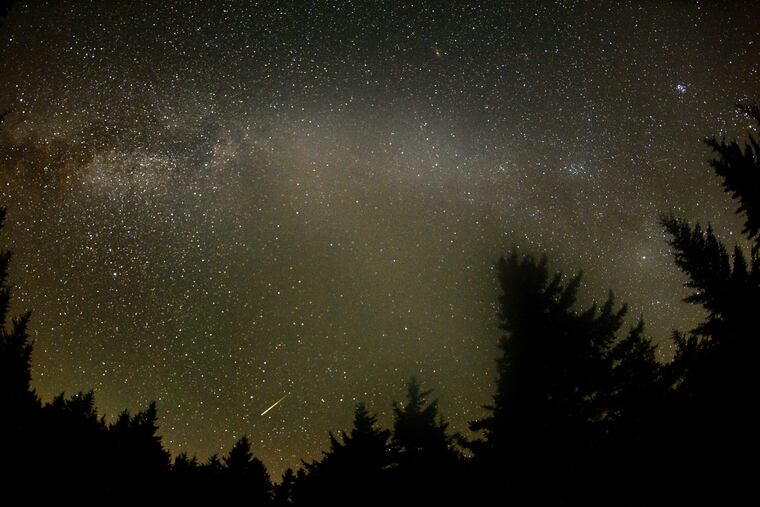Orionid meteor showers will be stars of night sky — and YouTube — this week
Fragments of Halley's Comet will be visible. Light pollution and the moon may get in the way, but meteors will be stars on YouTube.

Halley’s Comet isn’t due for a return engagement in the night sky until 2061, but remnants of it will be visible this week.
The annual Orionid meteor showers, consisting of Halley’s leftovers, will peak early Tuesday with perhaps 20 “meteors” appearing hourly.
Clouds are forecast to obscure the view during the peak, but some of those “shooting stars” should be visible during the rest of the week when viewing conditions will improve.
The meteors will appear to radiate from the constellation Orion, or “the hunter."
» READ MORE: Stargazing around Philadelphia: Everything you need to know
But in the Philadelphia area, even if the skies were perfectly clear, you likely would have trouble identifying Orion, which rises in the east after 9 p.m. That’s because of so-called light pollution.
Still, this year, come light pollution or overcast, the Orionids will be stars on YouTube.
Just what are ‘meteor showers?’
Primarily they are sand-grain-size particles of disintegrating comets. In the case of the Orionids, that would be Halley’s.
These fragments intersect with the Earth’s orbit on regular annual schedules. When they enter the atmosphere, they are burned to a crisp, yielding a streak of light in the process.
On occasion, a bigger chunk will hold together long enough to explode into a “fireball” on its interrupted descent to Earth.
» READ MORE: 'Pa. fireball:' Why the sky flashed green over Philly
(Incidentally, the phrase “meteoric rise” would be an oxymoron. Then again, why is a near-collision called a “near-miss?”)
On any given night, three to five meteors streak across the sky hourly. They become significantly more frequent during the “showers,” which occur more or less monthly.
» READ MORE: Perseid meteor shower peaks Monday, Tuesday nights
The busiest of the year are the Perseids, in mid-August, which can generate as many as 50 an hour.
What’s the best time to view the Orionids?
Good news for insomniacs: Peak time is early Tuesday, after midnight. The American Meteor Society has an excellent viewing guide.
The moon rises at 12:26 a.m. But it will be a little less than 40% full — a shadow of what it was last week — and it will take a few hours for its light to take hold. The moon will be even less of an issue the next few nights when the meteor activity will continue.
Unfortunately, clouds are forecast to build overnight Tuesday, but the meteor society offers this consolation: “If you are clouded out on the morning of Oct. 22, don’t despair as good rates will continue for a few more nights.”
Even with clear, moonless skies, a chronic challenge for people who live in urbanized areas is finding a dark spot for viewing.
If it is cloudy, or you don’t have access to a meadow or some other clearing that is devoid of light interference, you can tune into YouTube starting at 8 p.m. to watch the show. It can be watched later on YouTube after the live event has ended.
So whatever happened to the night sky?
We could blame Thomas Edison, but it wasn’t his idea to have malls, stadiums, and car dealerships beaming their lights skyward.
This so-called light pollution has all but obliterated the view of a night sky that once inspired the human imagination to create constellations.
According to the International Dark Sky Association, 80% of the world’s population now has an impaired view of those distant suns that once inflamed the night sky.